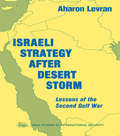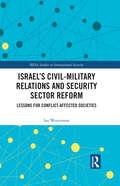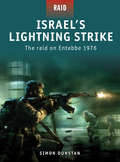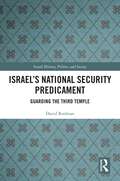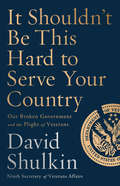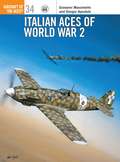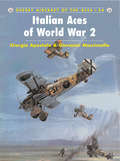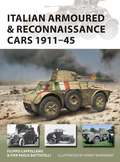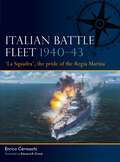- Table View
- List View
Israeli Strategy After Desert Storm: Lessons of the Second Gulf War (Besa Studies In International Security)
by Aharon LevranIraq's invasion of Kuwait and the Gulf War had a traumatic effect on the Middle East and its implications were particularly serious for Israel, which felt obliged to reassess its strategic and military perspectives. This is an examination of the lessons that the Gulf War holds for Israel.
Israel’s Civil-Military Relations and Security Sector Reform: Lessons for Conflict-Affected Societies (Besa Studies In International Security Ser.)
by Ian WestermanThis book examines Israel’s civil-military relations (CMR) in order to explore alternatives to orthodox Western models of security sector reform (SSR) in post-conflict societies. This book argues that the guidelines of SSR have always tended to draw on theoretical work in the field of CMR and focus too heavily on Western, liberal democratic models of governance. Consequently, reform programs based on these guidelines, and intended for use in post-conflict and conflict-affected states, have had, at best, mixed results. The book challenges the necessity for this over-reliance on traditional Western liberal democratic solutions and instead advocates an alternative approach. It proposes that by drawing on an unconventional CMR model, that in turn references the specific context and cultural background of the particular state being subject to reform, there is a significantly higher chance of success. Drawing on a case study of Israel's CMR, the author seeks to provide practical assistance to those working in this area and considers the question of how this unorthodox CMR model might usefully inform post-conflict and conflict-affected SSR programmes. This book will be of interest to students of military studies, security studies, Israeli politics, and International Relations.
Israel’s Civil-Military Relations and Security Sector Reform: Lessons for Conflict-Affected Societies (Besa Studies In International Security Ser.)
by Ian WestermanThis book examines Israel’s civil-military relations (CMR) in order to explore alternatives to orthodox Western models of security sector reform (SSR) in post-conflict societies. This book argues that the guidelines of SSR have always tended to draw on theoretical work in the field of CMR and focus too heavily on Western, liberal democratic models of governance. Consequently, reform programs based on these guidelines, and intended for use in post-conflict and conflict-affected states, have had, at best, mixed results. The book challenges the necessity for this over-reliance on traditional Western liberal democratic solutions and instead advocates an alternative approach. It proposes that by drawing on an unconventional CMR model, that in turn references the specific context and cultural background of the particular state being subject to reform, there is a significantly higher chance of success. Drawing on a case study of Israel's CMR, the author seeks to provide practical assistance to those working in this area and considers the question of how this unorthodox CMR model might usefully inform post-conflict and conflict-affected SSR programmes. This book will be of interest to students of military studies, security studies, Israeli politics, and International Relations.
Israel's Intelligence Assessment Before the Yom Kippur War: Disentangling Deception and Distraction
by Aryeh ShalevIsrael's flawed intelligence assessment in October 1973 has been studied intensively and been the subject of much public and professional debate. This book adds a unique dimension to previously disclosed material, as its author served as head of the Research Branch of Israeli Military Intelligence on the eve of and during the Yom Kippur War and as such was responsible for the national intelligence assessment at the time. Drawing on his personal records, and on interviews and extensive research conducted in the intervening decades, Aryeh Shalev examines the preconceptions and common beliefs that prevailed among Israeli intelligence officials and ultimately contributed to their flawed assessment: the excessive self-confidence in Israel's prowess, particularly in the aftermath of the Six Day War; the confidence that any surprise attack could be repelled with the regular army until the reserves were mobilised; the accepted profile of Sadat as a weak leader with limited powers and initiative; and the belief in Israel's correct understanding of Egyptian and Syrian operational plans . . . Beyond explaining where Israeli intelligence erred, the book probes expectations of military intelligence in general and the relationship between military and political assessments. It considers what kind of assessment an intelligence branch is capable of producing with a great degree of certainty, and conversely, what kind of assessment it should not be asked to produce. Based on the intelligence failure of the Yom Kippur War, this book also reviews possible organisational changes and methodological improvements to guard as much as possible against surprise attacks in the future, relevant not only to Israel's circumstances but to all countries with enemies capable of launching an attack. Published in association with the Institute for National Strategic Studies.
Israel’s Lightning Strike: The raid on Entebbe 1976 (Raid #2)
by Peter Dennis Simon DunstanThe Israeli Special Forces' operation at Entebbe goes down in history as one of the most audacious counter-terrorist assaults ever conducted. On 27 June 1976, four terrorists – two of the Popular Front for the Liberation of Palestine and two of the German Baader-Meinhof terrorist group – highjacked a passenger jet and forced a landing in Entebbe, Uganda. Here they were met by reinforcements, and – although releasing a few hostages – transferred all the Jewish and Israeli prisoners to the terminal building. As Idi Amin's assistance to the terrorists became increasingly clear, the Israeli government began preparations for a military assault. The element of surprise was crucial; never before had such a large-scale raid at such a long distance been successfully undertaken. This is the incredible story of how the Israeli Special Forces defied radar for over 2,000 miles, masqueraded as a tyrant in a Mercedes and captured uniforms, and defeated an army in brutal combat, in a triumph of sheer audacity and nerve. A compelling book chronicling an incredible moment in history.
Israel’s Lightning Strike: The raid on Entebbe 1976 (Raid #2)
by Simon DunstanThe Israeli Special Forces' operation at Entebbe goes down in history as one of the most audacious counter-terrorist assaults ever conducted. On 27 June 1976, four terrorists – two of the Popular Front for the Liberation of Palestine and two of the German Baader-Meinhof terrorist group – highjacked a passenger jet and forced a landing in Entebbe, Uganda. Here they were met by reinforcements, and – although releasing a few hostages – transferred all the Jewish and Israeli prisoners to the terminal building. As Idi Amin's assistance to the terrorists became increasingly clear, the Israeli government began preparations for a military assault. The element of surprise was crucial; never before had such a large-scale raid at such a long distance been successfully undertaken. This is the incredible story of how the Israeli Special Forces defied radar for over 2,000 miles, masqueraded as a tyrant in a Mercedes and captured uniforms, and defeated an army in brutal combat, in a triumph of sheer audacity and nerve. A compelling book chronicling an incredible moment in history.
Israel's National Security Predicament: Guarding the Third Temple (Israeli History, Politics and Society)
by David RodmanThis book provides a ground-breaking assessment of the Israeli national security experience from the establishment of the country through to the present day. Seventy-five years after its establishment, the State of Israel continues to face an acute national security predicament as a result of the still unresolved Arab–Israeli conflict. This monograph offers a new framework for analyzing this experience, first exploring the crucial events of the past and present that define it, including interstate wars, asymmetrical wars, low-intensity conflicts, and developments in weapons of mass destruction. The book then probes how Israel’s evolving national security doctrine has addressed these various challenges over the years, highlighting the roles of a number of variables: deterrence, warning, and decision; strategic depth and defensible borders; the quality and quantity of fighting men and machines; intelligence; self-reliance in military matters; foreign policy; and the influence of ethnic demography, societal resilience, economic prosperity, and water security. Written in accessible, non-technical language, the book will appeal to general readers seeking an introduction to Israeli security, as well as to specialists and researchers in various fields, including Israeli history, Middle Eastern politics, and security studies.
Israel's National Security Predicament: Guarding the Third Temple (Israeli History, Politics and Society)
by David RodmanThis book provides a ground-breaking assessment of the Israeli national security experience from the establishment of the country through to the present day. Seventy-five years after its establishment, the State of Israel continues to face an acute national security predicament as a result of the still unresolved Arab–Israeli conflict. This monograph offers a new framework for analyzing this experience, first exploring the crucial events of the past and present that define it, including interstate wars, asymmetrical wars, low-intensity conflicts, and developments in weapons of mass destruction. The book then probes how Israel’s evolving national security doctrine has addressed these various challenges over the years, highlighting the roles of a number of variables: deterrence, warning, and decision; strategic depth and defensible borders; the quality and quantity of fighting men and machines; intelligence; self-reliance in military matters; foreign policy; and the influence of ethnic demography, societal resilience, economic prosperity, and water security. Written in accessible, non-technical language, the book will appeal to general readers seeking an introduction to Israeli security, as well as to specialists and researchers in various fields, including Israeli history, Middle Eastern politics, and security studies.
Israel's Nuclear Option: Behind the Scenes Diplomacy Between Dimona & Washington
by Zaki ShalomIn the early 1950s, Israel secretly launched a project designed to achieve a nuclear option. Initially supported by France, this daring project stood to engineer a dramatic change in Israel's strategic position vis-a-vis its neighboring Arab states and the wider international community. A nuclear program was driven by the firm conviction of David Ben-Gurion that Israel's existence could be guaranteed only with the aid of such a deterrent. The ensuing nuclear defense strategy was upheld by successive Israeli governments. Adamantly opposed to America's request to allow external supervision of its nuclear activity, Israel labored to avert a potentially disastrous rift with its one superpower ally. Israel's Nuclear Option recounts the dialogue and related diplomatic activity that took place during the Kennedy and Johnson administrations and the Ben-Gurion and Eshkol premierships. The intense and often difficult discussions, which pitted Israel's security concerns against the United States' determined goal to stem nuclear proliferation, eventually produced a set of formal and informal strategic understandings regarding Israel's nuclear deterrence.
Israel's Reprisal Policy, 1953-1956: The Dynamics of Military Retaliation (Cass Military Studies)
by Ze'ev DroryFollowing Israel's War of Independence in 1948 and 1949, the anticipated peace did not materialize and the new nation soon found itself embroiled in protracted military conflict with neighbouring Arab states. Demobilization of its armed forces led to the formation of special elite unit under the command of Ariel Sharon to cope with cross-border infiltration, pillage and murder. A policy of deterrence was governed by the tactic of retaliation, which contained the seeds of escalation. At the same time, a military dynamic unfolded in which the logic of field unit response dictated both military and political policy and caught the imagination of a demoralized and war-weary Israeli society.The myth of the Israeli paratroopers at the beginning of the 1950s, and their heroic deeds in the reprisal raids, embodied the new Zionist ethos for which the current Prime Minister of Israel, Ariel Sharon, claims much of the credit. The book thus provides historical insight into some of the most intractable developments of the current Arab-Israeli conflict.
Israel's Reprisal Policy, 1953-1956: The Dynamics of Military Retaliation (Cass Military Studies)
by Ze'ev DroryFollowing Israel's War of Independence in 1948 and 1949, the anticipated peace did not materialize and the new nation soon found itself embroiled in protracted military conflict with neighbouring Arab states. Demobilization of its armed forces led to the formation of special elite unit under the command of Ariel Sharon to cope with cross-border infiltration, pillage and murder. A policy of deterrence was governed by the tactic of retaliation, which contained the seeds of escalation. At the same time, a military dynamic unfolded in which the logic of field unit response dictated both military and political policy and caught the imagination of a demoralized and war-weary Israeli society.The myth of the Israeli paratroopers at the beginning of the 1950s, and their heroic deeds in the reprisal raids, embodied the new Zionist ethos for which the current Prime Minister of Israel, Ariel Sharon, claims much of the credit. The book thus provides historical insight into some of the most intractable developments of the current Arab-Israeli conflict.
It Happens With Gurkhas: Tales from an English Nepali, 1944-2015
by J P CrossGurkhas have served with the British for almost 200 years, first with the army of the East India Company, then with the Indian Army of the Raj, and then in 1947 becoming an integral part of the British Army. This anthology of articles from The Kukri, the Gurkha regimental journals, by J.P. Cross covers much of the past sixty years of their history, taking in the last days of the Second World War and the Indonesian Confrontation in the 1960s, and also gives an insight into the everyday life, culture and beliefs of these renowned soldiers. As a Gurkha officer, J.P. Cross had many unusual experiences in his long career: in 1945, for example, he was attached to a Japanese battalion in Indochina that was fighting for the British against the Viet Minh, and the only photograph taken of this Japanese unit finally laying down its weapons appears in this book. Later, he just managed to resolve a potentially deadly dispute between an offended Gurkha and a visiting South Vietnamese trainee at the Jungle Warfare School. He also describes several seemingly supernatural experiences whilst serving with troops from a culture where such things are firmly believed in. This is a unique anthology of articles drawn from an equally unique military career and a relationship with the Gurkhas that has lasted for over half a century.
It Pays to Be Good
by Noel StreatfeildFlossie Elk was an astonishingly beautiful baby. But whilst her mother Fanny encouraged Flossie to use the power of those dazzling looks, her greengrocer father George stood by the belief that “Beauty is a lure of Satan.”When the First World War breaks out and George joins the army, Fanny sends her daughter to dance academy where Flossie’s beauty can shine like it’s never been able to before. Not before long Flossie is given a starring role on stage, but with less than honourable intentions . . .Carnegie Award winning author Noel Streatfeild explores the dark side of the backstage world, which she knows all too well from her own life, in this witty and enchanting wartime novel, It Pays to be Good.
It Shouldn't Be This Hard to Serve Your Country: Our Broken Government and the Plight of Veterans
by David ShulkinThe former VA secretary describes his fight to save veteran health care from partisan politics and how his efforts were ultimately derailed by a small group of unelected officials appointed by the Trump White House.Known in health care circles for his ability to turn around ailing hospitals, Dr. David Shulkin was originally brought into government by President Obama to save the beleaguered Department of Veterans Affairs. When President Trump appointed him as secretary of the VA, Shulkin was as shocked as anyone.Yet this surprise was trivial compared to what Shulkin encountered as secretary: a team of political appointees devoted to stopping anyone -- including the secretary himself -- who stood in the way of privatizing the agency and implementing their political agenda. In this uninhibited memoir, Shulkin opens up about why the government has long struggled to provide good medical care to military veterans and the plan he had to solve these problems. This is a book about the commitment we make to the men and women who risk their lives fighting for our country, how the VA was finally beginning to live up to it, and why the new administration may now be taking us in the wrong direction.
It Shouldn't Be This Hard to Serve Your Country: Our Broken Government and the Plight of Veterans
by David ShulkinThe former VA secretary describes his fight to save veteran health care from partisan politics and how his efforts were ultimately derailed by a small group of unelected officials appointed by the Trump White House.Known in health care circles for his ability to turn around ailing hospitals, Dr. David Shulkin was originally brought into government by President Obama to save the beleaguered Department of Veterans Affairs. When President Trump appointed him as secretary of the VA, Shulkin was as shocked as anyone.Yet this surprise was trivial compared to what Shulkin encountered as secretary: a team of political appointees devoted to stopping anyone -- including the secretary himself -- who stood in the way of privatizing the agency and implementing their political agenda. In this uninhibited memoir, Shulkin opens up about why the government has long struggled to provide good medical care to military veterans and the plan he had to solve these problems. This is a book about the commitment we make to the men and women who risk their lives fighting for our country, how the VA was finally beginning to live up to it, and why the new administration may now be taking us in the wrong direction.
It Touched Every Street: Stories of the soldiers, sailors, and civilians from Grangetown who served and died (Fallen Heroes of the Great War)
by Steve DuffyThe World War I memorial in Grange Gardens, Grangetown, Cardiff, has long been a focal point in the park, not only for the casual visitor but also for events of remembrance. It dates from 1921 and is a lasting record of the hundreds of men who gave their lives between 1914-18. But who were these people who made the ultimate sacrifice? Where did they live before enlisting? What did they do in civilian life? How and where did they die? The Grangetown Local History Society, together with volunteers set out to answer these questions. The starting point for the research was the 330 names of soldiers and sailors and their regiments/ships on the memorial. This seemed on the face of it a straightforward enough task, albeit time-consuming. What was not foreseen was discovering another 150 or so men and women had been omitted. It was only when we started examining the names in more detail that we come across anomalies, errors, and a few names which still remain a mystery. The research involved poring over newspaper columns, obituaries, and family notices in archives of the South Wales Echo, Western Mail and Cardiff Times . We also consulted the Commonwealth War Graves Commission records, military records of various kinds, including regimental diaries, as well as local directories and the Glamorgan Archive. There was a fair bit of cross-checking and online detective work, especially with some of the more elusive names. In this we were aided by the families of the fallen, who submitted their own stories and photographs, often involving their own research. Local historians also offered suggestions and snippets. The discovery of so many missing names of Grangetown casualties led to the project going further than its original intention. Progress has been updated on our website www.grangetownwar.co.uk. As the picture became clearer, we were able to compile street-by-street lists and casualty lists in date order. We commemorated each death on our Twitter feed as its centenary anniversary passed. The use of such technology would have been difficult to explain to the committee behind the memorial 100 years ago.
Italian Aces of World War 2 (Aircraft of the Aces)
by Richard Caruana Giorgio ApostoloFlying aircraft such as the Macchi 200-202, Fiat G.50 and biplane Fiat CR.42, the Italian fighter pilots were recognised by their Allied counterparts as brave opponents blessed with sound flying abilities, but employing under-gunned and underpowered equipment. Following the Italian surrender in September 1943, a number of aces continued to take the fight to the Allies as part of the Luftwaffe-run ANR, which was equipped with far more potent equipment such as the Bf 109G, Macchi 205V and Fiat G.55. Flying these types, the handful of ANR squadrons continued to oppose Allied bombing raids on northern Italy until VE-Day.
Italian Aces of World War 2 (Aircraft of the Aces #34)
by Richard Caruana Giorgio ApostoloFlying aircraft such as the Macchi 200-202, Fiat G.50 and biplane Fiat CR.42, the Italian fighter pilots were recognised by their Allied counterparts as brave opponents blessed with sound flying abilities, but employing under-gunned and underpowered equipment. Following the Italian surrender in September 1943, a number of aces continued to take the fight to the Allies as part of the Luftwaffe-run ANR, which was equipped with far more potent equipment such as the Bf 109G, Macchi 205V and Fiat G.55. Flying these types, the handful of ANR squadrons continued to oppose Allied bombing raids on northern Italy until VE-Day.
Italian Armoured & Reconnaissance Cars 1911–45 (New Vanguard)
by Pier Paolo Battistelli Henry Morshead Filippo CappellanoThe first Italian armoured cars were used in the war in Libya in 1911-12 against the Ottoman Empire. With few tanks being developed, the Italians relied instead on the development of more mobile armoured cars like the Ansaldo Lancia 1 Z, during World War I, but post-war the army, focusing on the Alpine battlegrounds of Italy's northern borders, did not consider armoured cars suitable for reconnaissance duties. The experience of the Spanish Civil War would provide the much needed last push for the Italians to develop modern armoured cars. The result were the famous AB 41-43 models, which fought against the British in North Africa and Marshall Tito's forces in Yugoslavia, along with other vehicles such as the AS 36 light armoured car.Using detailed colour plates and contemporary photographs, this book examines the development of the Italian armoured car in the two world wars and the inter-war years, from the deserts of North Africa to the slopes of the Alps.
Italian Army Elite Units & Special Forces 1940–43 (Elite #99)
by Pier Paolo BattistelliItalian military historian Pier Paolo Battistelli examines the elite and specialforces units of the Italian Army during World War II. This includes a vast array of troop types, including paratroopers, assault engineers, sea-landing and swimmer units, long-range recce and ski units, and even hand-picked Fascist 'Mussolini' units. It also delves into the specialist tank and armoured units that were created to emulate the German armoured units. While the Italian units discussed enjoyed mixed success, the volume draws attention to the incredibly hard fighting done by some in the deserts of North Africa and the frozen wastelands of Russia. Illustrated with rare archival photographs and specially commissioned artwork, this is a fascinating insight into a little-studied aspect of Axis forces.
Italian Army Elite Units & Special Forces 1940–43 (Elite)
by Pier Paolo Battistelli Johnny ShumateItalian military historian Pier Paolo Battistelli examines the elite and specialforces units of the Italian Army during World War II. This includes a vast array of troop types, including paratroopers, assault engineers, sea-landing and swimmer units, long-range recce and ski units, and even hand-picked Fascist 'Mussolini' units. It also delves into the specialist tank and armoured units that were created to emulate the German armoured units. While the Italian units discussed enjoyed mixed success, the volume draws attention to the incredibly hard fighting done by some in the deserts of North Africa and the frozen wastelands of Russia. Illustrated with rare archival photographs and specially commissioned artwork, this is a fascinating insight into a little-studied aspect of Axis forces.
The Italian Army in Slovenia: Strategies of Antipartisan Repression, 1941–1943 (Italian and Italian American Studies)
by Amedeo Osti GuerrazziThis powerful study offers a vivid and often disturbing account of the Italian army's occupation of Slovenia during World War II. It moves from the decision of the Italians to annex Slovenia in 1941, through local resistance and brutal reaction against civilians, to the army's ultimate collapse following Italy's defection from the Axis.
The Italian Army of World War I (Men-at-Arms)
by David Nicolle Raffaele RuggeriThe dilemma of the young Italian kingdom and the experience of her army in the Great War were unique among the combatant nations. Late to enter the war against the Central Powers, she faced a massively defended Austro-Hungarian front in the north, including strong mountain features, as well as distractions in the Balkans and a simultaneous rebellion in her Libyan colony. Costly and repeated battles on the Isonzo front culminated in the disaster of Caporetto in October 1917, followed by a remarkable revival and eventual victory in 1918. This concise study describes and illustrates the Italian Army's campaigns, organisation, uniforms, weapons and equipment – including the famous 'death companies' and Arditi assault troops.
The Italian Army of World War I (Men-at-Arms)
by David Nicolle Raffaele RuggeriThe dilemma of the young Italian kingdom and the experience of her army in the Great War were unique among the combatant nations. Late to enter the war against the Central Powers, she faced a massively defended Austro-Hungarian front in the north, including strong mountain features, as well as distractions in the Balkans and a simultaneous rebellion in her Libyan colony. Costly and repeated battles on the Isonzo front culminated in the disaster of Caporetto in October 1917, followed by a remarkable revival and eventual victory in 1918. This concise study describes and illustrates the Italian Army's campaigns, organisation, uniforms, weapons and equipment – including the famous 'death companies' and Arditi assault troops.
Italian Battle Fleet 1940–43: 'La Squadra', the pride of the Regia Marina (Fleet #6)
by Enrico CernuschiA comprehensive. illustrated account of the wartime Italian battle fleet, from its ships and technology to command structure, logistics, codebreaking and more.In the 1920s, the Italian Navy faced great challenges. Mussolini's ambitious Italy turned away from its alliance with Britain and France, and the Regia Marina faced the prospect of confronting both the French Navy and the Mediterranean Fleet of the Royal Navy. In the years leading up to World War II, the Regia Marina built and deployed a powerful battleship-led fleet – known in Italy as 'La Squadra' – intended to make the Mediterranean an Italian sea once more. In this book, Italian naval historian Enrico Cernuschi offers a fresh assessment of the wartime Italian battle fleet, based on his lifetime of primary-source research from both Italian and Allied sources. It offers a comprehensive portrait of this proud armada, how it was devised and built, and how it operated and fought. It covers a multitude of factors often overlooked, such as Italy's naval codebreakers, the fleet's logistics, and the qualities and limitations of Italian industry that supported it. The book also provides a concise account and analysis of the battle fleet's activities through the war, from major clashes such as the Battle of Calabria to lesser-known expeditions. The author's research into Italian wartime primary sources overturns some myths still commonplace in Anglo-American accounts. Illustrated with superb new artwork, maps and 3D diagrams, and featuring rare photos, this book is a fascinating account of Italy's great fleet of World War II.
